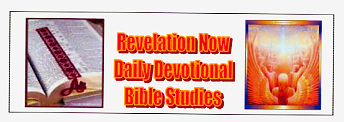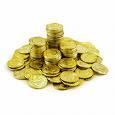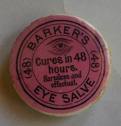
| Next | Previous | Index | Tellout Home |
19. Rich Laodicea City
Revelation 3.17-22
"You say, 'I am rich. I have acquired wealth and do not need a thing.' But you do not realize that you are wretched, pitiful, poor, blind, and naked. I counsel you to buy from me gold refined in the fire so that you can become rich, and white clothes to wear to cover your shameful nakedness, and salve to put on your eyes to see. Those whom I love I rebuke and discipline. So be earnest and repent. Here I am! I stand at the door and knock. If anyone hears my voice and opens the door, I will come in and eat with them, and they with me. I will give the victorious one the right to sit with me on my throne, just as I was victorious and sat down with my Father on his throne. Whoever has ears, let them hear what the Spirit says to the churches." (Revelation 3.17-22) ✞
Wretched Pitiful and Poor
 Laodicea City, on the river Lycus, benefitted from its position on an important trade route. The city and the church became "wealthy." They were also free of persecution like Sardis. But what the Laodiceans could buy became more valuable to them than their unseen and eternal spiritual assets. They said, "I am rich. I have acquired wealth and do not need a thing." But Jesus responded to them, "you do not realize that you are wretched, pitiful, poor, blind, and naked?" Laodiceans, who boasted of their wealth, relied on their successful healing eye ointment treatments and valuable clothing trade. ✞
Laodicea City, on the river Lycus, benefitted from its position on an important trade route. The city and the church became "wealthy." They were also free of persecution like Sardis. But what the Laodiceans could buy became more valuable to them than their unseen and eternal spiritual assets. They said, "I am rich. I have acquired wealth and do not need a thing." But Jesus responded to them, "you do not realize that you are wretched, pitiful, poor, blind, and naked?" Laodiceans, who boasted of their wealth, relied on their successful healing eye ointment treatments and valuable clothing trade. ✞
Poor In Heart
 Laodicea was also known for its "gold coins," which the Romans permitted them to produce. However, Christ told the Laodiceans to get their spiritual treasures from him. Gold refined in a fire was a glowing reference to God's grace. Refining gold involved mining the ore, crushing, and heating it intensely until the dross separated from the real gold. Laodicea would receive the same harsh spiritual treatment at God's hand until it left only pure gold. The city was so proud of its cloth and dyeing industries, but Christ told them to purchase white, spotless, clean clothes from him, symbolic of his righteousness. The Laodicean sheep produced beautiful black woolen fabric, but only the clean white clothing of the pure in heart will satisfy God. The Laodiceans exchanged their glossy black wool for the pure in heart's dazzling white linen clothes. ✞
Laodicea was also known for its "gold coins," which the Romans permitted them to produce. However, Christ told the Laodiceans to get their spiritual treasures from him. Gold refined in a fire was a glowing reference to God's grace. Refining gold involved mining the ore, crushing, and heating it intensely until the dross separated from the real gold. Laodicea would receive the same harsh spiritual treatment at God's hand until it left only pure gold. The city was so proud of its cloth and dyeing industries, but Christ told them to purchase white, spotless, clean clothes from him, symbolic of his righteousness. The Laodicean sheep produced beautiful black woolen fabric, but only the clean white clothing of the pure in heart will satisfy God. The Laodiceans exchanged their glossy black wool for the pure in heart's dazzling white linen clothes. ✞
Eye Salve
 Despite being famous for its eye ointment and purple woolen clothing, God accuses Laodicea of its shameful nakedness. It may be well clothed, but it was still spiritually naked. Wearing white clothes covered their "shameful nakedness." It also had "ointment for your eyes so that you can see." Laodicea's Medical Center made eye-salves from crushed Phrygian stone. Its precious "ointment" may have healed many eye problems, but Christ tells them they need spiritual medicine from him. They had to receive healing to see the truth and remove their spiritual blindness. ✞
Despite being famous for its eye ointment and purple woolen clothing, God accuses Laodicea of its shameful nakedness. It may be well clothed, but it was still spiritually naked. Wearing white clothes covered their "shameful nakedness." It also had "ointment for your eyes so that you can see." Laodicea's Medical Center made eye-salves from crushed Phrygian stone. Its precious "ointment" may have healed many eye problems, but Christ tells them they need spiritual medicine from him. They had to receive healing to see the truth and remove their spiritual blindness. ✞
Renowned Doctors
As if to explain why Jesus was chastising them, he says, "Those whom I love I rebuke and discipline. So be earnest and repent." The Laodicea medical center was famous in the ancient Roman world for its ear treatments, sent all over the known world. It was of considerable size, as attested by the massive columns from c100 BC discovered in the city's northern district. A bustling trade route brought many visitors seeking healing which made the city very wealthy. So renowned were its doctors that some of their names even appeared on Laodicean coins. We know of two doctors by name from these coins. One was called Zeuxis, an ophthalmologist specializing in eye diseases. Another doctor, Alexander Philalethes, was inscribed on a second coin. ✞
Little Bread Roll
 Eye salve was called "collyrium," meaning "course bread roll." "Bread roll" referred to a small roll of medicated eye salve. These contained crushed Phrygian stone, a light, porous stone resembling pumice used in the dyeing process. The added amber-colored essential oil "spice nard" or "spikenard" was derived from a Himalayan flowering plant in Nepal, China, and India. This oil served as a perfume and traditional medicine from India to Europe. People believed salve drew out "evil humor" in ancient times, which caused visual impairment or hearing loss. The Laodicean Church was so proud of the city's medical skills in caring for people's eyes and ears that it did not see itself spiritually blind and deaf. Therefore, the Lord says, "Those whom I love I rebuke and discipline." ✞
Eye salve was called "collyrium," meaning "course bread roll." "Bread roll" referred to a small roll of medicated eye salve. These contained crushed Phrygian stone, a light, porous stone resembling pumice used in the dyeing process. The added amber-colored essential oil "spice nard" or "spikenard" was derived from a Himalayan flowering plant in Nepal, China, and India. This oil served as a perfume and traditional medicine from India to Europe. People believed salve drew out "evil humor" in ancient times, which caused visual impairment or hearing loss. The Laodicean Church was so proud of the city's medical skills in caring for people's eyes and ears that it did not see itself spiritually blind and deaf. Therefore, the Lord says, "Those whom I love I rebuke and discipline." ✞
Jesus Door Knocking
 In an attempt to illustrate this famous Revelation 3.20 verse, "I stand at the door and knock," the artist William Holman Hunt (1827-1910) produced his famous painting "The Light of the World." Hunt was an English artist who co-founded the London Pre-Raphaelite Brotherhood in 1848 with John Everett Millais (1829-1896) and Dante Gabriel Rossetti (1828-1882.) This brotherhood sought a return to the abundant detail, intense colors, and complex Italian art compositions. Hunt believed the world should be read as a visual sign system and incorporated into his paintings. The artist attempted to show Jesus knocking at our heart's door and appealing to our being's very center. Hunt wrote that "One can only open the human heart's door from the inside." ✞
In an attempt to illustrate this famous Revelation 3.20 verse, "I stand at the door and knock," the artist William Holman Hunt (1827-1910) produced his famous painting "The Light of the World." Hunt was an English artist who co-founded the London Pre-Raphaelite Brotherhood in 1848 with John Everett Millais (1829-1896) and Dante Gabriel Rossetti (1828-1882.) This brotherhood sought a return to the abundant detail, intense colors, and complex Italian art compositions. Hunt believed the world should be read as a visual sign system and incorporated into his paintings. The artist attempted to show Jesus knocking at our heart's door and appealing to our being's very center. Hunt wrote that "One can only open the human heart's door from the inside." ✞
Popularity
 Paul Kuritz, the American theatre and film critic, points out, "Hunt painted the entire painting out of doors whenever the moon was full, from nine o'clock in the evening until five o'clock the next morning." Some suggest that Hunt found the dawn light he needed outside Bethlehem on his Holy Land visits. His oil painting on canvas was celebrated and went viral, so much so that crowds of people paid a fee to view it in Keble College, Oxford. Hunt painted a smaller version between 1851 and 1856 and later a bigger, life-sized version. His eye-sight was failing, and he needed the help of another artist Edward Robert Hughes (1832-1908) to finish it. ✞
Paul Kuritz, the American theatre and film critic, points out, "Hunt painted the entire painting out of doors whenever the moon was full, from nine o'clock in the evening until five o'clock the next morning." Some suggest that Hunt found the dawn light he needed outside Bethlehem on his Holy Land visits. His oil painting on canvas was celebrated and went viral, so much so that crowds of people paid a fee to view it in Keble College, Oxford. Hunt painted a smaller version between 1851 and 1856 and later a bigger, life-sized version. His eye-sight was failing, and he needed the help of another artist Edward Robert Hughes (1832-1908) to finish it. ✞
World Tour
Between 1905 and 1907, the painting drew large crowds on a world tour. Robert Fulford (1932-present), a Canadian journalist in 2007, claimed that four-fifths of Australia's population viewed it. Hunt stressed in these paintings how much Jesus wants to share fellowship and friendship with us. He wants us to open up our lives, minds, and emotions to him. He is persistent in trying to get through to us, not breaking in but knocking gently on our heart's doors. ✞
Door Handle
 Jesus graciously allows us to decide whether or not to respond to him. Note that in the painting, the door's handle is curiously not shown on Jesus' side of the door but is presumably on the other side. The question is, "Do you hear Jesus knocking on your heart's door?" Will you open the handle on your side to him? At the end of this letter to Laodicea, John of Patmos urges Christian believers to listen and take his words to heart. Each church received a different message, but all contained warnings and guidance for that generation that apply equally today. ✞
Jesus graciously allows us to decide whether or not to respond to him. Note that in the painting, the door's handle is curiously not shown on Jesus' side of the door but is presumably on the other side. The question is, "Do you hear Jesus knocking on your heart's door?" Will you open the handle on your side to him? At the end of this letter to Laodicea, John of Patmos urges Christian believers to listen and take his words to heart. Each church received a different message, but all contained warnings and guidance for that generation that apply equally today. ✞
"Rich Laodicea City"
by Ron Meacock © 2021
| ^Top Page | Next | Previous |